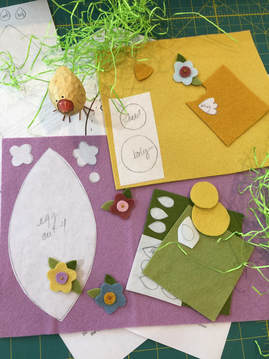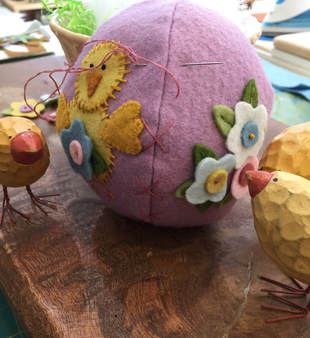I love getting comments and emails from all of you. Often, they are questions on how to do techniques. So, I have decided to add some how-to's to my blog. Today, it will be Sweet Stitched Easter Eggs! These sweet eggs are fun and easy! Follow here, and I hope you learn something new!  Step Two. Trace all the motifs onto freezer paper. Trace on the dull side of freezer paper with a pencil. Each freezer paper template can be reused up to five or six times so trace extra egg shapes, leaves, and flowers. One each of the motifs (lamb, chick...) will be enough for all the eggs.  Step Three. Press the freezer paper templates. Rough cut the freezer paper templates out and place onto corresponding wool felt colors with the shiny side down. Press with a hot, dry iron. Cut out on the traced line. Peel freezer paper off the cut out wool felt piece. Reuse the freezer paper template to cut out more egg shapes, flowers and leaves. One wonderful advantage of wool felt and felted wool appliqué is the you can use either side of the wool! This means, I only need to trace one chick wing and I can cut two wings and flip either one to face which ever direction I need!  Step Four. Glue motifs to egg shapes. You need four egg petal shapes for each egg. So there are four sides. I put a flower cluster on opposite sides of the egg and a motif on opposite sides. You can change this up of course! This will be in the example used. In this post, I will be making a chick egg. One great hint I can share here is shown in the example. I always include the finished design in my pattern pages. This way, you can use this pattern page to build your chick or lamb. Put your pattern page right onto your ironing board. Then I put the body of the chick on the pattern page, then I add a small dot of glue where the head and wing will overlap. Place these shapes onto the body matching the outside edges of the head and wings from the pattern page. Then I hit them with the iron to help dry the glue. At this point, I scoot them of the pattern page and build another chick in the same manner. After the second chick is done, I can pick up a whole chick turn it over add a couple spots of glue and place it on the egg shape. Let the glue dry before starting step five.  Step Five. Whipstitching. I whipstitch all the motifs in place. I use one strand of floss that matches the wool color I am going to sew in place. I do not do a blanket stitch. You can if you want but it is not necessary. I let the pretty wool felts or wools be the star and delicate light whipstitch holds them on. In each pattern is an example of how to do the whipstitch. Note: On this pattern I do not whipstitch the flowers or leaves. They are held on with french knots and backstitches. See the next step... Step Six. Embroidery. I use three strand of floss for most of my embroidery work on wool felts. The wool felts or wools tend to absorb the stitches so I use more strands and do not pull too tightly so my stitches stay on top of the wool. Most embroidery on the wool felts is simple. So I recommend drawing your embroidery lines by your own hand. No need to trace. If you use a removable pen ( Frixion - heat removable or, blue water removable pens) you can take your bad lines off and re-do! The flowers all get a french knot in the center to hold them down The french knot is three strands and I wrap the needle three times to make a significant knot for the center of each flower. The leaves are backstitched veins holding them on. Just tuck a leaf under the flower and back stitch in place with three strands of green floss. Eyes on my little characters are three stranded french knots in black floss but only two wraps of the needle. The eyes tend to get leaning if there are two many wraps. I like my eyes to be tight little perfect knots. When embroidery is done, remove your guide lines. Step Seven. Sewing. Here you get to see my messy backs! I do not worry about it. It is all inside on the step 8! Now, lay two egg shapes right sides together. Clip or pin to hold in place. A flower cluster shape on top of a chick shape. Starting 1/4 inch from the top, sew along the right side only. Stop 1/4 inch from the bottom. Repeat for the next two egg shapes. Open up your joined halves. Place right sides together and clip or pin. Make sure your tops match at the joined seams. I had one seam going to the right and one seam going to the left to minimize bulk. Sew around leaving an opening for turning and stuffing on one side only at the point shown on the pattern page.  Step Eight. Turn and stuff. Turn your egg inside out. Being careful not to catch embroidery threads and pulling on them. I always check before stuffing in case I have pulled on a french knot and it needs a little touch up! Stuff with small bundles of stuffing at a time. While stuffing, I am kind of shaping the egg as I go. When you have sufficient stuffing, Turn the raw edges into the stuffing and sew closed by hand with a single strand of matching floss.  Step Nine. Finishing. With two strands of floss I made big X's down the side seams. I thought it gave fun little extra stitches. You can make it more fun with crazy stitches going down the sides! I hope these eggs make you smile and reading this helps you feel confident to create and fill your home with sweet spring things! Happy Stitching, Barri Sue
3 Comments
9/5/2019 02:46:28 am
Happy Spring to everyone! It makes me happy to know that there are several activities you want us to do! Some of it does not require too much effort that is why I would love to try all of these! You don't need to go and get our of your house just to achieve these; all you need to do is to get the materials and follow the steps that are all written above! This is making me excited; I guess, I need to invite my friends to join me!
Reply
Leave a Reply. |
AuthorBarri Sue Gaudet designer for Bareroots, stitcher, mom and grandma, friend, hiker, quilt and knitting shop owner, and now, blogger. Archives
|





 RSS Feed
RSS Feed